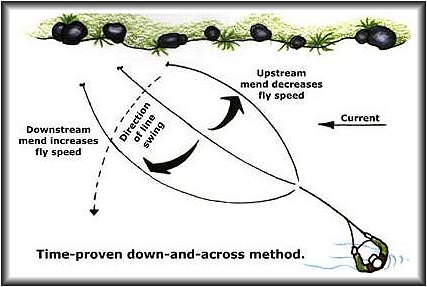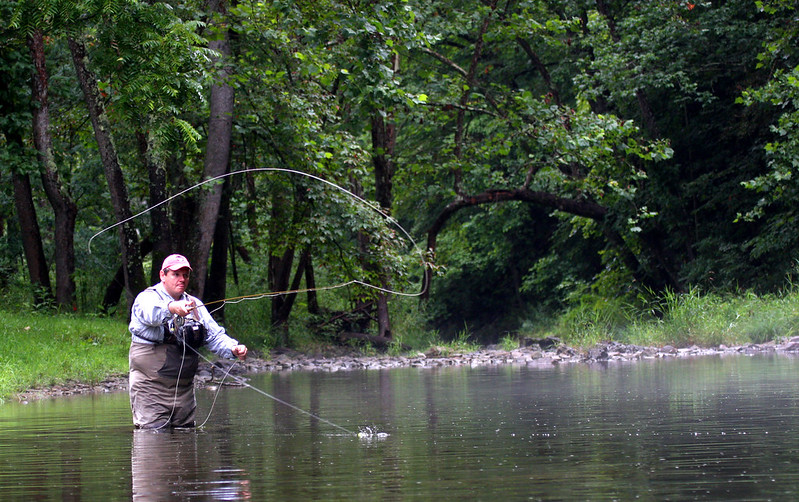Down and across is a popular fly fishing technique used by anglers to target a variety of species in both freshwater and saltwater environments. This technique involves casting the fly line across the water and allowing it to drift downstream while pulling the line back upstream with the rod tip. This creates a natural, lifelike presentation of the fly that can entice fish to strike.
One of the key elements of the down and across technique is the casting motion. The angler starts by pointing the rod tip downstream and making a forward cast. As the fly line begins to straighten out on the water, the angler lifts the rod tip up and back, creating a gentle curve in the line. This curve allows the fly to drift downstream with the current while the line is pulled back upstream by the rod tip. The angler should aim to keep the line as straight as possible while pulling back on it, which will help to maintain a natural drift of the fly.

The down and across technique is especially effective when fishing for species such as trout and salmon. These fish tend to lie in the current and wait for food to come to them, making the lifelike presentation of the fly an important factor in getting them to strike. The technique is also useful when fishing for species such as bass and panfish, which tend to hold in specific areas of the river or lake, such as the edges of weed beds or drop-offs. The angler can use the down and across technique to present the fly to these fish without spooking them.
In addition to the casting motion, the choice of fly is also important when using the down and across technique. For freshwater fishing, a variety of nymphs, streamers and wet flies can be used, depending on the species of fish being targeted and the conditions of the water. For saltwater fishing, the angler can use a wide variety of flies, including Clouser minnows, Deceivers and Lefty’s Deceivers, that imitate the baitfish, crustaceans, and other prey that the target species feed on.
When fishing with the down and across technique, the angler should pay attention to the current and adjust the speed of the retrieve accordingly. The goal is to keep the fly moving at the same speed as the current, which will help to create a natural drift. The angler should also pay attention to the water depth and adjust the amount of line that is allowed to drift downstream. This will help to keep the fly in the strike zone for longer periods of time and increase the chances of getting a bite.
Another important aspect of the down and across technique is the use of a strike indicator. A strike indicator is a small buoyant device that is attached to the fly line and helps the angler detect when a fish takes the fly. This can be especially useful when fishing in fast-moving water, where it can be difficult to see the fly and detect a subtle take. Strike indicators can be made of a variety of materials, including foam, yarn, or plastic, and come in a variety of shapes and sizes.
Overall, the down and across technique is a versatile and effective way to target a wide variety of species in both freshwater and saltwater environments. It requires a good casting motion, the right choice of fly and attention to the current, water depth, and strike indicator. By mastering the down and across technique, anglers can increase their chances of catching fish and enjoy the sport of fly fishing to the fullest.
In summary, the down and across technique is a versatile and effective method for catching a wide range of fish in both freshwater and saltwater environments. The key to success with this technique is a proper casting motion, an appropriate choice of fly, and attention to the current, water depth, and use of a strike indicator. By mastering the down and across technique, anglers can improve their chances of success and fully enjoy the sport of fly fishing.
